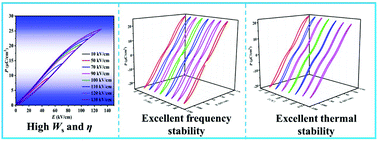An effective approach to achieve high energy storage density and efficiency in BNT-based ceramics by doping AgNbO3†
Abstract
Perovskite dielectric materials for capacitors have received wide attention in recent years because of their fast charge/discharge rates and high power densities. In this work, lead-free relaxor ferroelectric ceramics of (1 − x)[(Bi0.55Na0.45)0.94Ba0.06]0.98La0.02TiO3–xAgNbO3 were synthesized by a conventional sintering method. All ceramics are situated at the morphotropic phase boundary (MPB) of rhombohedral and tetragonal phases, suggesting that a small amount of AgNbO3 (abbreviated as AN) doping does not affect this phase-coexistence structure. The added AN not only improves the dielectric breakdown strength (DBS) from 84.11 kV cm−1 (x = 0) to 137.89 kV cm−1 (x = 0.01), but also broadens the phase transition peak and enhances the relaxation behavior of ceramics. Moreover, when x = 0.01, the ceramic demonstrates a high saturation polarization (Ps) of 25.54 μC cm−2 and a low remanent polarization (Pr) of 0.65 μC cm−2 at an electric field of 130 kV cm−1. More importantly, an optimal energy storage density (Ws) of 1.697 J cm−3 and energy efficiency (η) of 82.3% are simultaneously achieved in the BNBLT–0.01AN ceramic with excellent thermal stability (∼25–175 °C) and frequency stability (∼10–80 Hz).



 Please wait while we load your content...
Please wait while we load your content...